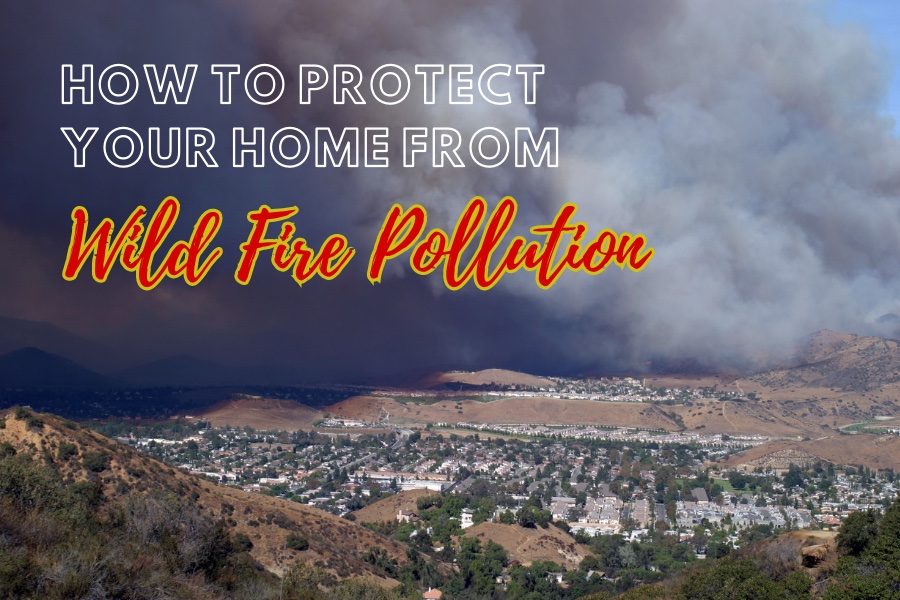
You’ve seen the destructive impact of forest fires, especially across the American West, where each summer a new wave of wildfires threatens homes, causes havoc to natural environments, and disrupts life for millions of people.
But the consequences of wildfires reach far beyond physical damage. Air pollution created by these catastrophic events often threatens the health and wellness of people living far away from the fire itself.
In this guide, we’ll help you understand the risks forest fires present to your health and home, and we’ll walk you through the most important steps to protect your home and family from forest fire air pollution.
Basics of Forest Fire Pollution – 5 Quick Facts
- Forest fire smoke reaches indoors. Make no mistake. When forest fires occur, the resulting smoke, ash, and particulate matter can get inside of homes and buildings. This tainted air can have serious health effects on humans, animals, and plants in the affected areas.
- Fires create thousands of pollutants. Wildfire smoke is a complex mixture of gases and particles, containing thousands of different chemicals. These include pollutants like carbon monoxide, nitrogen oxides, volatile organic compounds, polycyclic aromatic hydrocarbons, and sulfur dioxide.
- Different fires, different risks. Different types of fires tend to produce dramatically different levels of air quality deterioration. The specific composition of smoke depends on the type of vegetation burning, the temperature of the fire, and whether the fire reaches an urban area.
- Wildfire pollution travels great distances. Fine particles and pollutants emitted during wildfires can be carried by winds for hundreds or even thousands of miles, affecting air quality in geographically distant regions.
- Problems extend beyond breathing. While respiratory effects are commonly associated with exposure to wildfire smoke, there are broader health impacts. Fine particles and pollutants in smoke can enter the bloodstream and affect multiple organ systems, potentially leading to cardiovascular problems, exacerbation of existing conditions, and increased susceptibility to respiratory infections.

Ideas for Long-Term Solutions to Improve Indoor Air Quality
Having an IAQ device which continuously monitors the air quality in your home is an invaluable tool to protect your health and wellbeing.
Follow these tips on how to manage and mitigate the impact of wildfire smoke on indoor air quality, personal health, and drinking water.
Before a Fire – Preparation
If you live in an area where wildfires are common, especially during dry seasons, it’s a good idea to take a few actions to prepare your home for the worst.
- Get an indoor air quality monitor
Knowledge is power. To know what you’re dealing with, you’ll need an indoor air quality monitor that provides accurate readings on what is in your home’s air, as well as relative danger levels.
- Seal your house
Find and fix leaks and drafts of air that are getting into your house. Consider contracting a licensed professional to conduct an energy assessment.
- Upgrade your air filters
If you have central heating or air conditioning, upgrade to a filter designed to capture smoke particles, such as a high-efficiency particulate arrestance air filter.
- Get an air purifier
An air purifier with a HEPA filter can help remove smoke particles from the air. Use these in the rooms you spend the most time in.

During a Fire – Protecting Indoor Air
During times when a forest fire is already burning nearby, here are some actionable steps to take immediately.
- Keep windows and doors closed
Prevent more pollutants from entering your home by keeping all windows, doors, and vents closed.
- Set HVAC to recirculate
Ensure your HVAC system is set to recirculate air instead of pulling in outside air. Run your air purifier if you have one.
- Avoid increasing indoor pollutants
Avoid stoves, gas appliances, smoking, using fireplaces, burning candles, or spraying aerosols, all of which can increase indoor air pollution.
- Keep surfaces clean
Smaller air particles tend to collect and linger on indoor surfaces. Regularly clean commonly used surfaces throughout the house using a disinfectant.
- Create a clean room
When air quality becomes extremely poor, select one room in your house where you can limit exposure to polluted air. Pick a room with few windows and doors, and place an air purifier in it for best results.
- Mitigate negative pressure
Balance your HVAC system, avoid using indoor exhaust systems unless necessary, and seek professional help if needed.

Personal Protection from a Forest Fire
When wildfires are active in your area, there is only so much you can do to protect yourself. But here are a few tips to keep in mind.
- Limit outdoor activities
Stay indoors as much as possible and limit physical exertion to reduce the amount of smoke you inhale.
- Stay hydrated
Drink plenty of fluids to help your body cope with the drier conditions caused by smoke.
- Wear a mask
If pollution is bad enough, a properly fitted N95 or P100 mask can add some protection from inhaling harmful smoke particles.
- Protect your eyes
Wear protective eyewear, like goggles, which do not have ventilation holes to protect your eyes from smoke.
- Cleanse your skin
If you’ve been outside in heavy smoke, consider taking a shower and changing into fresh clothes once you’re back indoors.
- Plan to evacuate
It’s a good idea to have a “go bag” and a planned evacuation route in case fires get dangerously close. When smoke gets bad enough to cause discomfort in your breathing, it’s probably time to leave.

Water Safety
It’s important to know that wildfire smoke and ash can contaminate the local water supply.
- Recognize the threat
Wildfire smoke and ash can potentially contaminate both surface water and groundwater supplies.
- Use public water
Rely on your local public water system to treat and remove impurities. Keep an eye on the local news and follow any advisories about water safety.
- Manage private wells
Have your well water tested if a wildfire has occurred nearby and consider actions to protect the wellhead from contamination.
How to Monitor Indoor Air Quality to Spot Signs of Trouble During Wildfire Season
Forest fires can cause chaos, destruction, and disruption to indoor air quality. If you’re worried about the potential health impacts of smoke and ash, your first move should be to know what’s in your home’s air.
IAQ is an easy-setup air quality monitor that helps you stay informed. It measures smoke, VOCs, and particulate matter, and alerts you when changes occur so that you can take action.
Check out IAQ and join our crowdfunding campaign!






